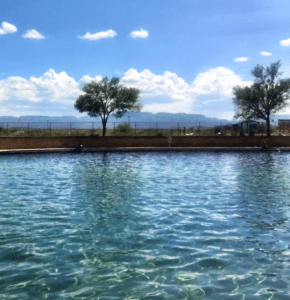Nestled in the heart of West Texas, Balmorhea State Park stands as a testament to nature’s wonders, with its jewel being the iconic spring-fed pool that has captured the hearts of visitors for decades. However, beyond the sparkling waters lies a rich tapestry of history and ecology, waiting to be explored. In this article, we will delve into the geological and historical significance of Balmorhea’s unique spring system, examining its role in local ecology and the dedicated efforts in conservation and preservation.
Geological Marvels: Balmorhea’s springs are no ordinary water sources; they are geological marvels that have shaped the landscape over centuries. The park boasts a series of artesian springs, with the crown jewel being San Solomon Springs, a true oasis in the arid desert environment. Fed by the extensive underground aquifer, these springs give rise to a pool that spans 1.3 acres and reaches depths of up to 25 feet. The crystal-clear waters are not only a sight to behold but also provide a glimpse into the intricate geological processes that sustain this unique ecosystem.
Historical Significance: Beyond their geological significance, the springs at Balmorhea hold a historical allure that adds depth to the park’s narrative. Built by the Civilian Conservation Corps (CCC) in the 1930s, the park was a New Deal project that aimed to provide employment during the Great Depression. The spring-fed pool was a key component of this undertaking, designed not only for recreational purposes but also as a habitat for aquatic life. As visitors swim in these historic waters, they are, in essence, immersing themselves in a living relic of American history.
Ecological Importance: Balmorhea State Park isn’t just a haven for swimmers and sunbathers; it plays a crucial role in local ecology. The spring-fed pool and the surrounding area serve as a refuge for a diverse array of plant and animal species. Visitors can witness unique aquatic life, from fish to invertebrates, thriving in the clear waters. The delicate balance of this ecosystem underscores the importance of responsible tourism and conservation efforts to ensure the longevity of this natural treasure.
Conservation and Preservation: Recognizing the ecological importance of Balmorhea’s springs, ongoing efforts in conservation and preservation have become paramount. Collaborative initiatives between local authorities, environmental organizations, and the community aim to safeguard this delicate ecosystem. From water quality monitoring to habitat restoration projects, these endeavors seek to maintain the park’s ecological integrity while allowing visitors to continue enjoying its natural beauty.
Conclusion: Balmorhea State Park’s springs are more than a refreshing escape; they are a window into geological history and a haven for biodiversity in the Texas desert. As visitors explore the depths of this natural oasis, they become part of a legacy that spans generations. By understanding and appreciating the geological and historical significance, we can ensure that Balmorhea’s springs continue to captivate and inspire for years to come, fostering a harmonious coexistence between nature and those who cherish its wonders.



